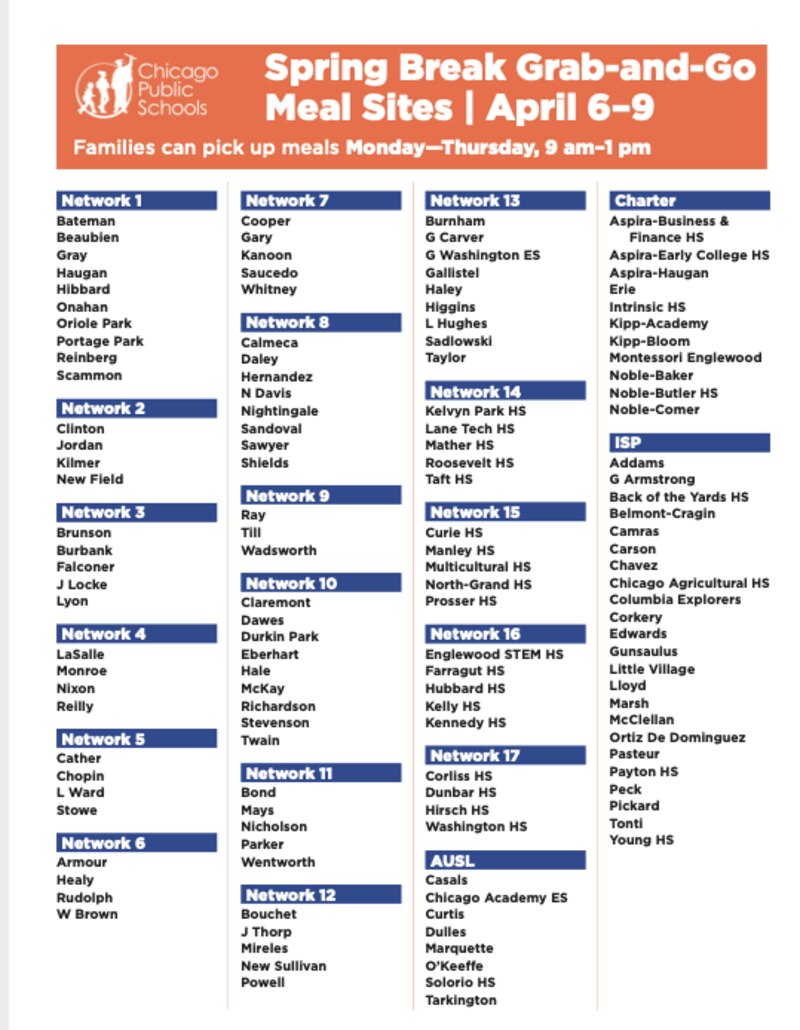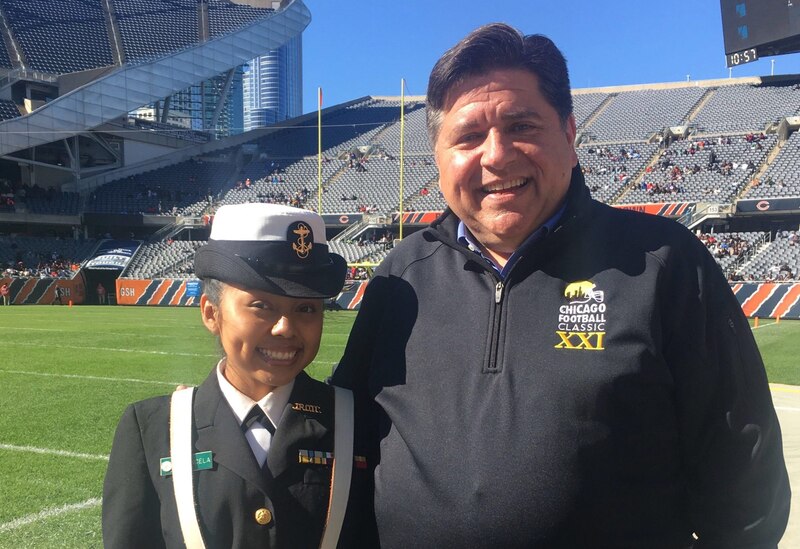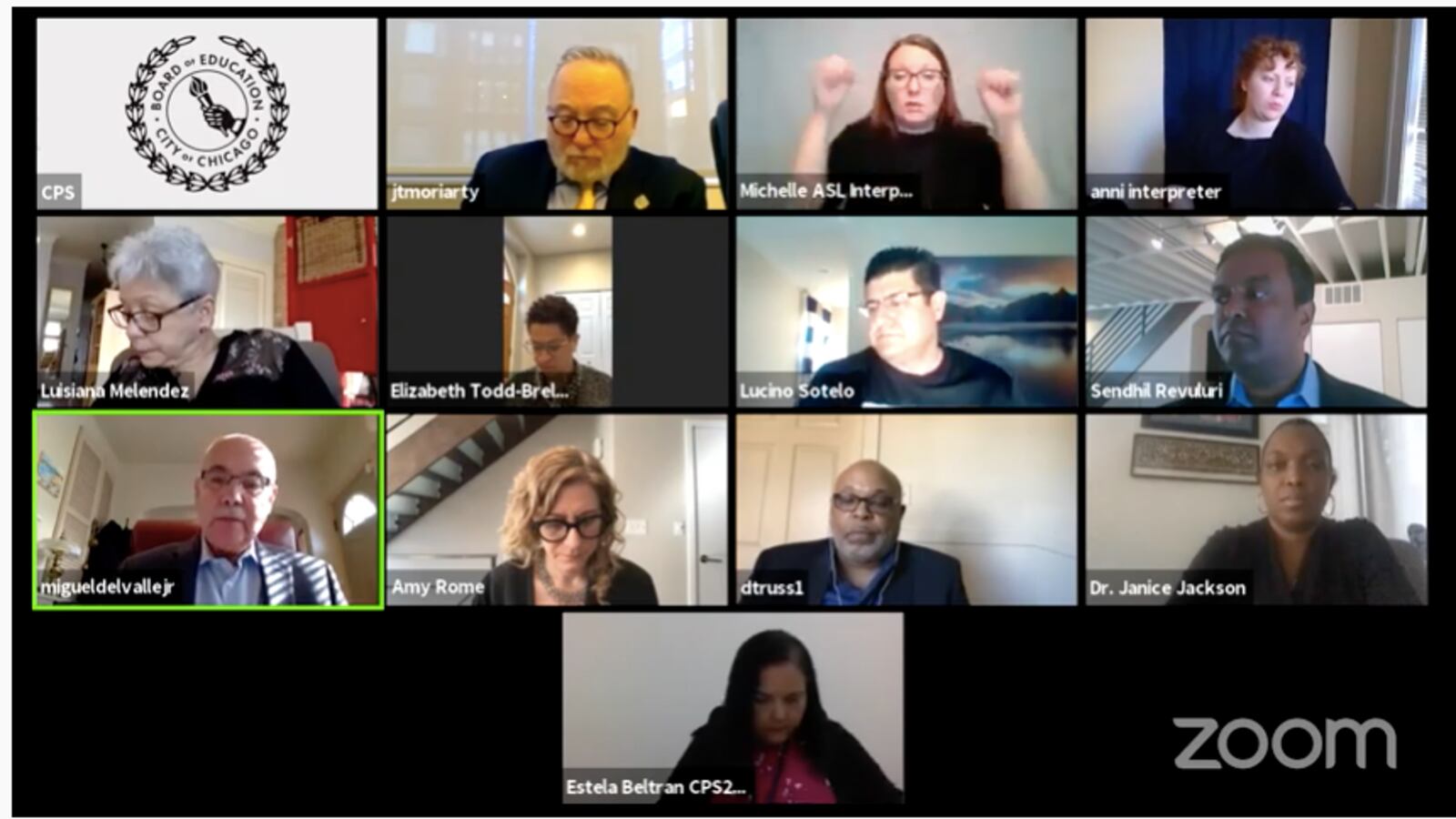With the number of Illinois COVID-19 cases still rising, it’s starting to sink in: Children are going to be out of school for several more weeks due to the worldwide coronavirus pandemic.
How will that impact learning?
We’ll be updating this blog regularly with news, insights, and information. Have tips or questions or suggestions of what we should cover? Email us at chicago.tips@chalkbeat.org.
For our previous blog chronicling the first 12 days of the crisis, click here.
Need help with homeschooling? We’re holding a virtual event with five Illinois educators on April 2. Learn more here.
🔗April 2
🔗Union secures promise of no layoffs, this year, for teachers, say leadership
As the landscape of teaching has shifted in a way that was almost unimaginable just weeks ago, union leadership assured Chicago teachers that there would be no layoffs or pay cuts, at least for this school year.
Speaking to teachers on a tele-town hall, Chicago Teachers Union leaders said they had secured an agreement on key personnel issues that included pay and benefit protections, as well as flexibility on grievance filing timelines, and a promise that teachers wouldn’t be placed on remediation plans during the coronavirus-related school closures.
“We have it in writing from CPS that we will continue to be paid. No teachers will be laid off for this school year,” union President Jesse Sharkey said on the call Wednesday night.
As teachers transition to remote learning that the district is mapping out in coming weeks, teachers on the call asked about workload, tenure, and the role of paraprofessionals.
A teacher named Samantha asked about the number of hours she was expected to be online, and how that time would be divided between planning and direct contact with students. “Our principal is very adamant that we sign up for 4-hour blocks,” Samantha said.
Another educator, Natalie, said she felt the hourlong teaching blocks were just too long for her fifth grade students. “It would be great to get some clarity as it pertains to age group and what is appropriate instructional time,” she said.
Sharkey said that, according to the union’s conversations with the district, school leadership had been instructed to approach remote learning with a “degree of understanding.” He also promised that the union would support teachers during this time.
“If employers are asking outrageous things of us, we want to push back,” he said, responding to a teacher who said his principal expected him to work during spring break.
The Chicago Teachers Union has been seen as a national model for “common good” union organizing, where unions fight for issues beyond the traditional bounds of wages and labor conditions, since current leaders came to power a decade ago. s unemployment and other social and economic fallout from the coronavirus response grow, Vice President Stacey Davis Gates, I will be up to the union to organize for more support for members and families.
“This is actually the calm before the storm,” Gates said, encouraging members to talk to families and keep a list of needs and concerns. “That is the kind of information that is going to help us make an ask.”
🔗How Chicago should spend $205 million in COVID-19 relief funds
We offered a first look on Wednesday about how much money Illinois school districts can expect to get from the federal government for coronavirus emergency measures, including ramping up spending on digital devices and remote learning. Find a lookup tool where you can search for your district here.
On Thursday, the Chicago Teachers Union zeroed in on the $205 million coming to Chicago Public Schools. In a statement, union President Jesse Sharkey called on the district to use the extra funds to spend on digital learning, as it has said it will do, but to also speed up hiring of nurses, social workers, and other staffers that were part of the most recent contract agreement.
“Needs include the hiring up of clinician staff to be able to deal one-on-one with student needs, family counseling and health needs,” he said. “Funds must go to set up school service infrastructure for full scale community schools—including trauma supports, housing and health services, small class sizes—services that must be deployed now and be fully up and running for students’ return to school.”
The union said it is calling on the district to staff up now, instead of spreading out hiring across five years as it has pledged to do.
Chicago Public Schools has estimated that the cost of fully implementing the latest contract with the teachers’ union and the union that represents some support staff will add $1.5 billion to its budget across five years. That was before COVID-19.
🔗April 1
🔗Chicago to cut number of food pickup sites by half starting next week
Chicago Public Schools, which has provided a staggering 2.8 million meals to families since school closures went into effect earlier this month, will consolidate its food distribution efforts starting Monday.
During spring break, which is scheduled to run April 6-10, the district will provide meals at 136 schools, down from 500-plus when the effort started. Then, starting April 13, Chicago will offer food at 276 locations.
The district said Wednesday it dropped sites where there was lowest demand, and that fewer sites will allow it to rotate front-line workers and administrators, freeing up some principals to help steer remote learning plans that are also rolling out April 13.
Here is the full list of sites for spring break week.

🔗Now we have an estimate of federal money for school emergency response
Illinois is expected to receive $569.5 million in emergency school funds from the federal government to spend on its coronavirus response, the state’s top educator has told district leaders. Of that, Chicago is slated to receive $205 million. Read more here.
🔗Two brothers. Little classwork. A lot of worries.
“I was overwhelmed before,” says 16-year-old Sarah Alli-Brown, a Chicago charter school student who is caring for her two young brothers while her mother is at work. “But now I’m overwhelmed even more.”
For so many students struggling to manage the many stresses in their lives — whether due to poverty, community violence, or caregiving responsibilities — school is the glue helping to hold it all together. What happens when school ceases to be? Chalkbeat national reporter Kalyn Belsha takes a look.
🔗March 31
🔗Illinois extends school closures
Gov. J.B. Pritzker said Tuesday that the statewide school closure mandate will extend to at least April 30, and that the order will include Chicago Public Schools.
The governor addressed the impact on students directly in his speech. Read more here.
🔗New rules for remote learning
With longer school closures looking like a reality, the state board of education issued new guidance for districts around remote learning. Here are five things to know.
🔗March 30
🔗Illinois tells schools they must draft a learning plan during closures
Illinois school districts, including Chicago, this week are releasing to parents more detailed guidelines for remote learning, now that guidance from the Illinois State Board of Education is in.
Late Friday evening, the state school board released a nearly 60-page document with recommendations from a 63-member remote learning advisory group. It spans such topics as attendance, grading, and instructional planning..
Schools must implement remote learning or e-learning to give students access to educators, the state said. The state will count any days missed from March 17-30 because of school closures as student attendance days that won’t be required to be made up. The state also recommends that schools adopt a pass/incomplete grading model so that students will not be penalized.
Chicago plans to release details of its plan Monday afternoon in a press conference with Mayor Lori Lightfoot, who has said that digital device distribution is a key priority of her administration. According to a 2018 survey, 145 of Chicago’s 500-plus schools provide devices for every student. Here’s what we know so far. We will report back with more later today.
🔗March 27
🔗More than 600 providers apply for emergency child care licenses statewide
More than 600 Illinois child care providers have applied for licenses to help care for children of first responders and health care professionals on the front lines of the coronavirus epidemic, Gov. J.B. Pritzker said Friday.
Pritzker said that child care providers may apply for a one time grant starting Monday to help address any additional costs. Licensed homes may receive $750, centers with one or two classrooms may receive $2,000 and centers with three or more classrooms may receive $3,000.
Illinois earlier this week ordered child care centers for children under 5 to close, but allowed them to apply for an emergency license to stay open. The state has said that centers that close will not lose their public funding to care for low-income children. However, many centers also accept some private tuition, and owners have said they hope to benefit later from government aid for small businesses.
State public health officials on Friday announced 488 new cases of COVID-19 and eight additional deaths. That brings Illinois’ total count to 3,026 cases and 34 deaths as of Friday afternoon.
🔗How long could closures last in Illinois?
By the end of this week, four states had said they planned to extend school closures through the end of the school year.
Illinois isn’t there yet. Gov. J.B. Pritzker’s office said Friday that he will “continue monitoring the data that evolves daily and base his decisions off the science and recommendations from experts.”
In a call with reporters Friday afternoon, Chicago Mayor Lori Lightfoot said her team, including schools chief Janice Jackson and CPS leaders, is looking to the state for guidance and also consulting with leaders of other large districts.
Chicago Public Schools has said its campuses are closed at least through April 20, while a statewide school closure mandate extends through April 8.
Lightfoot said she is concerned about Chicago’s limitations when it comes to e-learning.
“It’s no secret we have a one-room schoolhouse when it comes to access to broadband, digital equipment that would help facilitate e-learning,” she said. “That’s something I’m very focused on and in active conversations with CPS about. It’s a challenge for us, but it’s a challenge I’m determined I’m going to meet. We owe it to our kids. We just do.”
Earlier in the week, the city’s school board granted district leaders the authority to spend $75 million on coronavirus response, including technology. The district said a remote learning plan was coming this week, and it was also weighing how it could purchase devices and distribute them in a way that would prioritize highest-need households first. But it did not offer specific plans. (More here on that.)
The mayor also said Friday that Chicago Public Schools had so far served more than 2 million meals.
But the demand isn’t equal across all school sites, and whether the school district could consolidate distribution sites is “actively under discussion,” Lightfoot said in response to a question from Chalkbeat.
Coronavirus cases among frontline school workers have impacted food distribution in other American cities.
“There are a number of different variables that we are looking at to make sure we are focusing our resources at areas of the city where we need it most,” the mayor said. “My hat is off to folks at CPS and to the frontline workers who’ve been doing a tremendous job to make sure their students and families are fed.”
🔗House passes federal stimulus bill that includes money for schools
The bill, which the Senate passed Thursday, includes $13.5 billion for schools for remote learning technology, costs associated with sanitizing school buildings, and paying for summer learning programs, among other coronavirus-related expenditures. Now it goes to President Donald Trump. Read more here.
🔗March 26
🔗Questions about emergency child care weigh on Chicago
One recurring question facing Chicago, and every other city in the country, is what to do about child care for health care workers, first responders, and other essential employees.
Chicago kept day cares and child care centers open longer than schools, but it ultimately shut them. The state has started issuing emergency licenses for some centers to keep operating and care for small groups of children. The state did not have an immediate answer to how many operators have applied for those licenses.
Chicago is offering free in-home child care through Sittercity. Some centers are also staying open through the emergency license program, but the city did not have a readily available number, either.
Responding to a public letter from the city’s teachers union that said the city was considering reopening schools near hospitals to care for children, Mayor Lori Lightfoot acknowledged that such a plan was under consideration. In response to union concerns about the safety of teachers who might be put at risk by working, the mayor emphasized that staff would be “volunteer.”
In response to questions from Chalkbeat later Thursday, the mayor’s office said that the plan to open emergency child care centers in schools is one of several contingency plans on the table.
“The mayor’s office is developing multiple contingency plans for providing emergency child care to health care and other essential workers in the event that such care is needed to ensure that our critical systems can continue to operate. The proposal in question is not being implemented at this time.”
“As announced on Monday, first responders are encouraged to take advantage of the city’s partnership with Sittercity, which has created a mechanism by which in-home care can be provided.”
🔗“Something miraculous has happened in Washington.”
Speaking Thursday about the bipartisan effort in the Senate to pass a federal bill that would provide relief for coronavirus, Illinois Democratic Sen. Dick Durbin said Thursday that “something miraculous had happened in Washington.”
“We’ve done something on a timely basis,” he quipped.
Durbin spoke as part of Gov. J.B. Pritzker’s daily press briefing on coronavirus and its impact. As of midday Thursday, Illinois has reported 2,538 cases and 26 deaths.
The stimulus bill, which must now go to the House, includes significant sums for schools. The biggest chunk: $13.5 billion to be distributed among states, which would have to pass most of that on to school districts and charter schools for buying technology for remote learning, sanitizing school buildings, and paying for summer learning programs. (Click here to read Chalkbeat coverage of the bill.)
Durbin praised provisions to help hospitals “hanging by a thread” to meet patients’ needs, small businesses, the airline industry, and households through cash payments.
“To some people that’s money they desperately need,” he said.
Meanwhile, Pritzker announced a new Illinois Covid Response Fund, which has already raised almost $23 million from philanthropic organizations, businesses and individuals, including $2 million from Pritzker and his wife. The fund, led by the governor’s sister, former U.S. Commerce Secretary Penny Pritzker, will distribute the dollars to local nonprofits and other organizations on the front lines of the state’s response to the pandemic.
🔗 It’s official: Illinois can waive standardized tests this spring
The federal government granted the Illinois State Board of Education permission to waive all federally required assessments and accountability measures for the current school year.
The federal Department of Education quickly approved the state board’s waiver application. This means that all schools across the state will maintain their current state ratings for next school year. Schools that receive extra state funds to improve achievement will continue to get those amounts next year.
🔗March 25
🔗CPS’ $75 million emergency fund
In a virtual meeting punctuated by the occasional technology glitch and appearance from a child, Chicago’s Board of Education on Wednesday unanimously approved $75 million for the coronavirus response, allowing leaders to sign contracts and make purchases without prior board approval through June.
District officials said they need the flexibility to spend on cleaning schools, providing school meals, paying frontline staff — and filling gaps in student access to computers and the internet.
Until now, Chicago Public Schools has been largely mum about the district’s plans to ramp up remote learning — though officials promised more details later this week.
Read more here about the district’s plans to double down on devices. And click here to read more details about the $75 million spend, which the union called a “blank check.”
🔗College goers face unprecedented uncertainty

Chicago has seen an increase in students entering college, a source of pride for the district over the past few years. But there’s widespread concern among students, high school counselors, and educators that coronavirus could seriously interrupt that progress this year. Here’s how some students are coping with the disruption.
Want to read more about the impact of coronavirus and public schools in Illinois? Find our previous coverage here.
Willing to share your story about the impact on your classroom or on your family? Write us as chicago.tips@chalkbeat.org.

